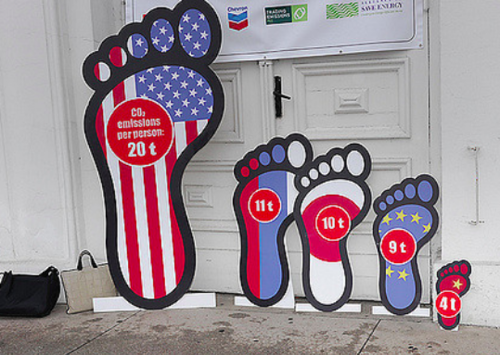
A carbon footprint is a measure of the total greenhouse gas emissions caused directly and indirectly by a person, organization, event or product. It is not so much a "footprint" as a metaphor for human impact on the atmosphere in terms of carbon dioxide and other greenhouse gases released by human activities. (Note that while the term itself only refers to carbon, it is a measure of all the greenhouse gases.)
Sources of greenhouse gas from human activities
Numerous human activities do, or have to the potential to, release greenhouse gases into the atmosphere. Major sources include land clearance (and habitat destruction), transportation, energy production and usage, agriculture, manufacturing and construction.
Origins of the concept of footprint as a measure
Carbon footprint is a term borrowed from the ecological footprint measure developed by Rees and Wackernagel.
Measuring carbon footprints
Measuring a carbon footprint begins with making an inventory. The scope of the inventory is dependent on the context of what and who is being measured but you can find accounting standards created by the World Business Council for Sustainable Development and the the World Resources Institute that form the basis of the Greenhouse Gas Protocol. This Protocol is used internationally to quantify greenhouse gases and to recommend ways to manage the emissions.
In the United States, the non-profit The Climate Registry created its own protocol.
Ways to reduce your carbon footprint
As an individual, there are things you can do to reduce your individual carbon footprint, including:
- Walk and cycle more often and leave the car at home.
- Do not fly. An hour spent on an airplane increases your carbon footprint more than an hour spent on most other activities. People who fly frequently have among the highest personal carbon footprints on the planet.
- Turn off all appliances on stand-by when not in use. You'll reduce your power bill.
- Buy less stuff. Think twice as to whether or not you really need the item.
- Recycle, reuse and repurpose wherever you can rather than replacing with a new object requiring new resources to create it.
- Switch to compact fluorescent lights over the more energy intensive incandescent ones.
- Turn down the thermostat and learn to wear a sweater or cover up with a quilt instead of using more energy to stay warm. Physical exercise is the best form of keeping warm!
- Eat lower on the food chain, and avoid any foods that are air-freighted or grown out of season in greenhouses heated by fossil fuels. The carbon footprints of different foods vary by more than a factor of ten on a per-food-calorie basis.[1] Foods with the lowest associated carbon footprints include most grains, pulses, root vegetables, and anything you grow yourself without fossil fuel inputs. Foods with the highest carbon footprints include meats, dairy, processed foods requiring refrigeration, and anything air-freighted or grown in most greenhouses. (Greenhouses in Iceland are an exception as they are geothermally heated.)
See also
References
Interwiki links
- wikipedia:Business action on climate change
- wikipedia:Carbon footprint
- wikipedia:Ecological footprint
- wikipedia:Environmental impact of aviation
- wikipedia:Hypermobility (travel)
- wikipedia:Individual action on climate change
- wikipedia:Individual and political action on climate change
- wikipedia:Preston curve
External links
- ↑ "The Impacts - 2011 Meat Eater's Guide to Climate Change + Health". Environmental Working Group. 2011. Archived from the original on 2012-03-26. "Lamb, beef and cheese have the highest emissions. This is true, in part, because they come from ruminant animals that constantly generate methane through their digestive process, called enteric fermentation. Methane (CH4) – a greenhouse gas 25 times more (CH4) potent than carbon dioxide (CO2), accounts for nearly half the emissions generated in this study’s Nebraska beef production model (...). Pound for pound, ruminants also require significantly more energy-intensive feed and generate more manure than pork or chicken (...)."